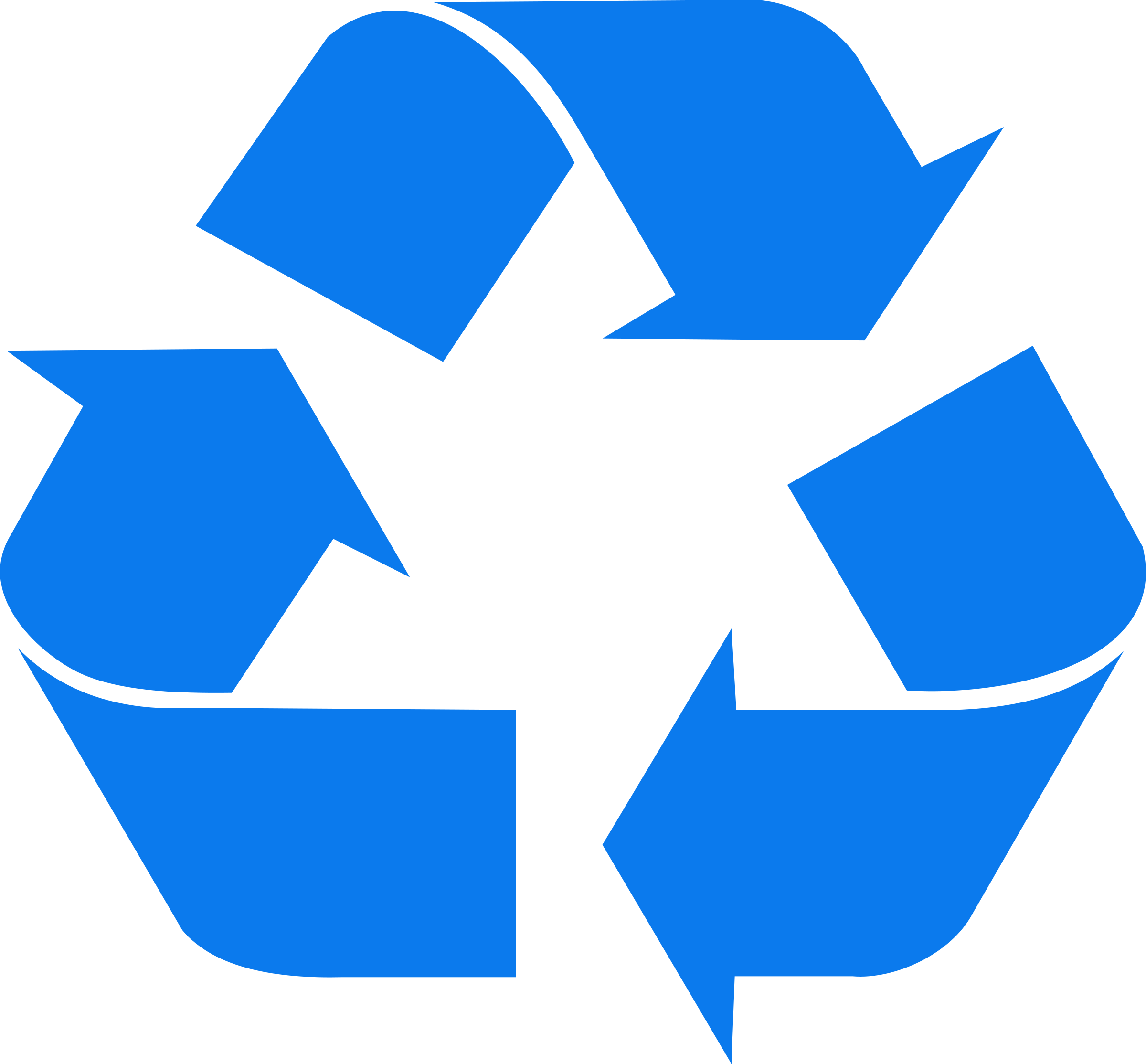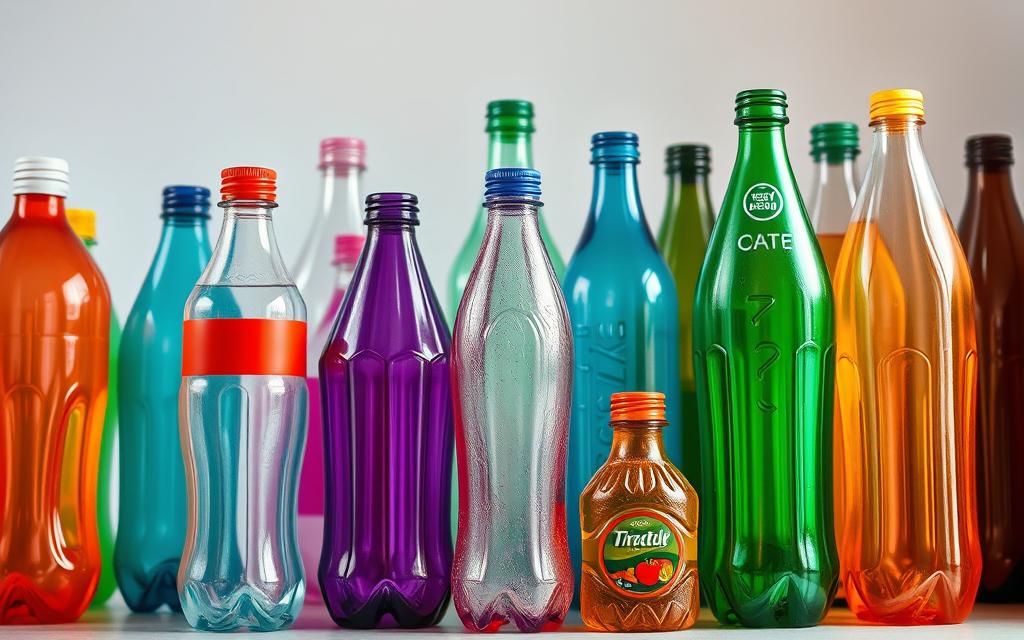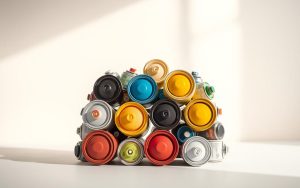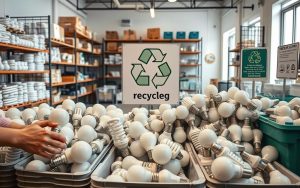Every day, over 50 million single-use containers are discarded in the United States. As environmental advocate Annie Leonard famously said, “There is no away… when we throw anything away, it must go somewhere.” This staggering statistic highlights the urgent need for better waste management solutions.
While reusing these containers for beverages is not recommended due to safety concerns, there are countless creative ways to give them a second life. From home projects to gardening solutions, the possibilities are endless. This article explores over 60 innovative ideas to transform these items into useful and practical solutions.
Repurposing these materials not only reduces waste but also fosters creativity. Whether you’re looking for kids’ crafts or practical home innovations, there’s something for everyone. Discover how simple changes can make a big impact on the environment while adding value to your daily life.
Ready to explore more? Check out our comprehensive guide for inspiration and step-by-step instructions.
Introduction to Recycling Plastic Bottles
The environmental crisis caused by improper disposal of single-use items is growing daily. Most containers are made from PET/PETE, a durable yet non-biodegradable material. While recycling helps, it has limitations. Over time, these materials degrade, reducing their quality and usability.
Improper disposal leads to microplastic contamination in oceans and landfills. These tiny particles harm marine life and enter the food chain. Upcycling offers a superior alternative, transforming old plastic into new, functional items. This approach reduces waste and minimizes environmental harm.
According to Recyclops, office waste is a leading contributor to landfills. Traditional decomposition takes up to 450 years, while immediate reuse prevents this issue. Many believe reusing containers for food is safe, but this is a misconception. DIY solutions not only save costs but also promote creativity and sustainability.
| Method | Benefits | Drawbacks |
|---|---|---|
| Recycling | Reduces raw material use | Degrades over time |
| Upcycling | Creative, immediate reuse | Requires effort |
| Landfill | None | Long-term environmental harm |
Health considerations are crucial when repurposing containers for food or drink. Always ensure materials are safe and clean. By embracing upcycling, we can make a significant impact on the environment while adding value to our daily lives.
DIY Projects for the Home
Transforming everyday items into functional pieces is a rewarding way to reduce waste. With a little creativity, you can turn common materials into practical and decorative solutions for your home. These projects are not only eco-friendly but also cost-effective and fun for the whole family.
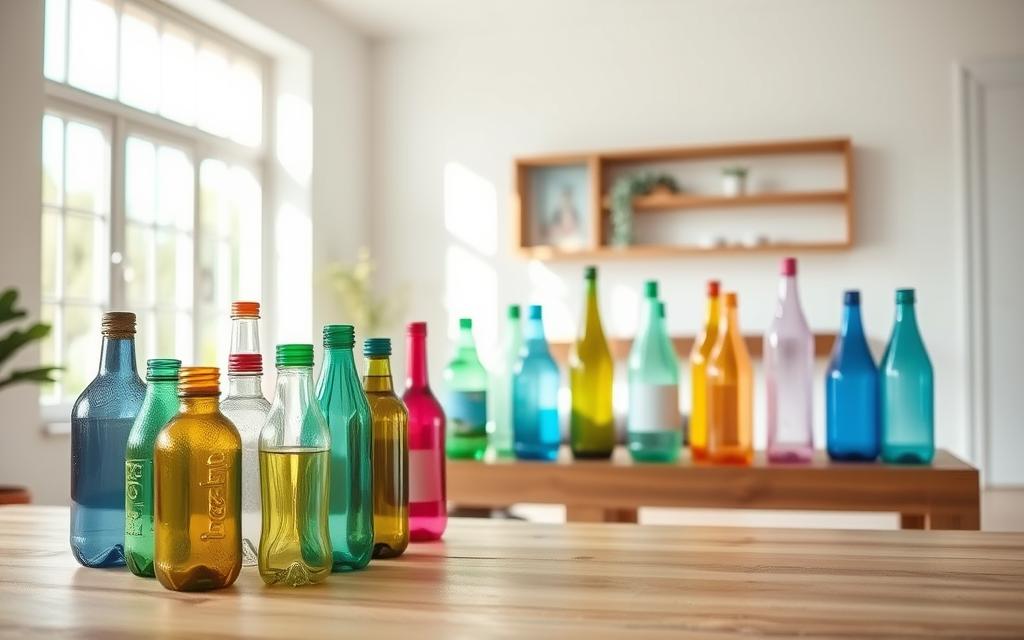
Bird Feeders
Create a simple bird feeder using a 2L container. Cut holes near the base and insert wooden spoons as perches. Fill it with birdseed, and hang it outside using a sturdy string. This project is perfect for beginners and helps attract wildlife to your yard.
Terrariums
Turn a clear container into a mini ecosystem. Layer activated charcoal, pea gravel, and soil to create a base. Add small plants and decorative stones for a beautiful indoor display. This project is ideal for adding a touch of greenery to your home.
Piggy Banks
Make a fun and functional piggy bank by cutting a money slot into a container. Decorate it with acrylic paints or decoupage for a personalized touch. This project is great for teaching kids about saving money while reusing materials.
These DIY ideas are not only practical but also encourage creativity and sustainability. By reusing materials, you can make a positive impact on the environment while adding value to your home.
Gardening and Outdoor Uses
Sustainable gardening practices often start with simple, reusable tools. Repurposing everyday items can enhance your outdoor space while reducing waste. From watering solutions to decorative planters, these DIY ideas are both practical and eco-friendly.
Watering Containers
Turn a detergent bottle into a handy watering can. Drill small holes in the cap for an even flow. This method is perfect for gentle watering, especially for delicate plants. It’s a cost-effective way to keep your garden hydrated.
Hanging Planters
Create unique planters by cutting a plastic bottle at an angle. Fill it with soil and your favorite greenery. Hang it vertically for a space-saving solution. This technique also improves root aeration, promoting healthier growth.
DIY Sprinklers
Transform a plastic bottle into a simple sprinkler. Puncture multiple holes along the sides and attach it to a hose. Adjust the hole patterns for different spray coverage. This is ideal for watering larger areas efficiently.
These projects not only enhance your outdoor space but also contribute to a greener planet. By reusing materials, you can create functional and beautiful solutions for your garden.
Creative Crafts for Kids
Engaging children in creative activities is a fantastic way to teach sustainability while having fun. These projects not only spark imagination but also introduce important concepts like recycling and resourcefulness. From jetpacks to planters, these ideas are perfect for a fun-filled day.
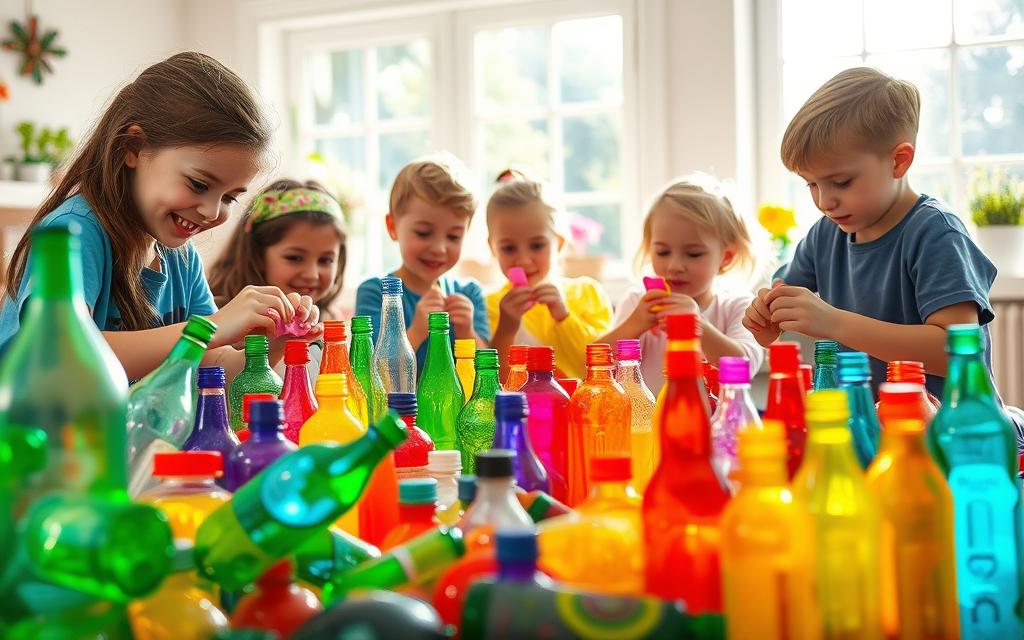
Jetpacks
Turn a simple bottle into a thrilling jetpack costume. Use spray caps for nozzles and secure straps for a snug fit. This project is a hit at parties and encourages kids to explore basic aerodynamics. Always supervise cutting and assembly for safety.
Wind Spiral Mobiles
Create mesmerizing wind spirals using wooden dowels and colorful bottle sections. Balance is key for smooth spinning. This craft teaches kids about physics and design while adding a decorative touch to any space.
Animal Planters
Transform bottles into adorable animal planters. Sculpt facial features using bottle sections and paint for a personalized touch. These planters are perfect for small herbs or succulents, making them both functional and fun.
“Creativity is the key to sustainability. When we teach kids to repurpose, we’re shaping a greener future.”
| Craft | Skills Learned | Materials Needed |
|---|---|---|
| Jetpacks | Aerodynamics, Design | Bottles, Spray Caps, Straps |
| Wind Spirals | Balance, Physics | Bottles, Wooden Dowels, Paint |
| Animal Planters | Sculpting, Gardening | Bottles, Paint, Soil |
These crafts are perfect for classrooms, parties, or a creative day at home. By using non-toxic materials and following safety protocols, you can ensure a safe and enjoyable experience for everyone involved.
Practical Storage Solutions
Organizing your home efficiently can be both practical and eco-friendly. Repurposing everyday items into functional storage solutions not only reduces waste but also enhances your living space. From the kitchen to the office, these ideas are simple, creative, and effective.
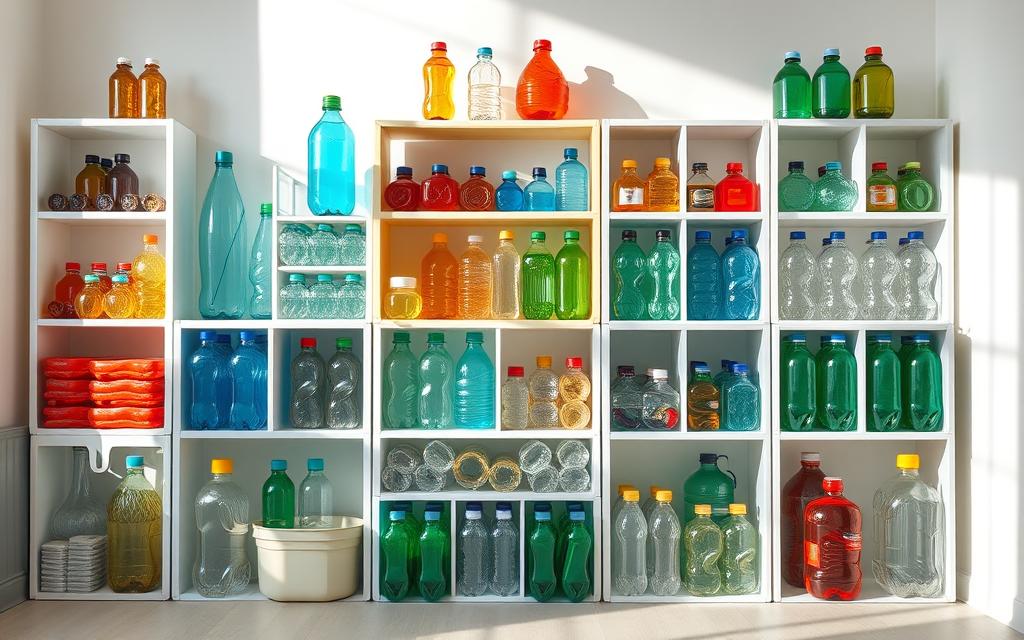
Snack Containers
Transform empty containers into airtight snack holders. Add silicone seals to the lids for better freshness. These are perfect for storing nuts, chips, or dried fruits. Label them with chalkboard paint for easy identification.
Utensil Holders
Create ergonomic utensil holders for your kitchen drawers or countertops. Cut and decorate plastic bottles to fit your needs. These holders keep your tools organized and within reach, making meal prep a breeze.
Magazine Holders
Reinforce plastic bottles to craft sturdy magazine holders. Use them to organize your reading materials or office supplies. Their lightweight design makes them easy to move around, adding functionality to any room.
“Efficient storage is the foundation of a clutter-free and stress-free environment.”
These solutions are not only practical but also environmentally conscious. By reusing materials, you can create a more organized and sustainable home.
Innovative Upcycling Ideas
Innovative upcycling transforms everyday waste into functional art. By rethinking how we use materials, we can create sustainable solutions that benefit both the environment and our daily lives. From vertical gardens to water filters, these ideas showcase the potential of creative reuse.
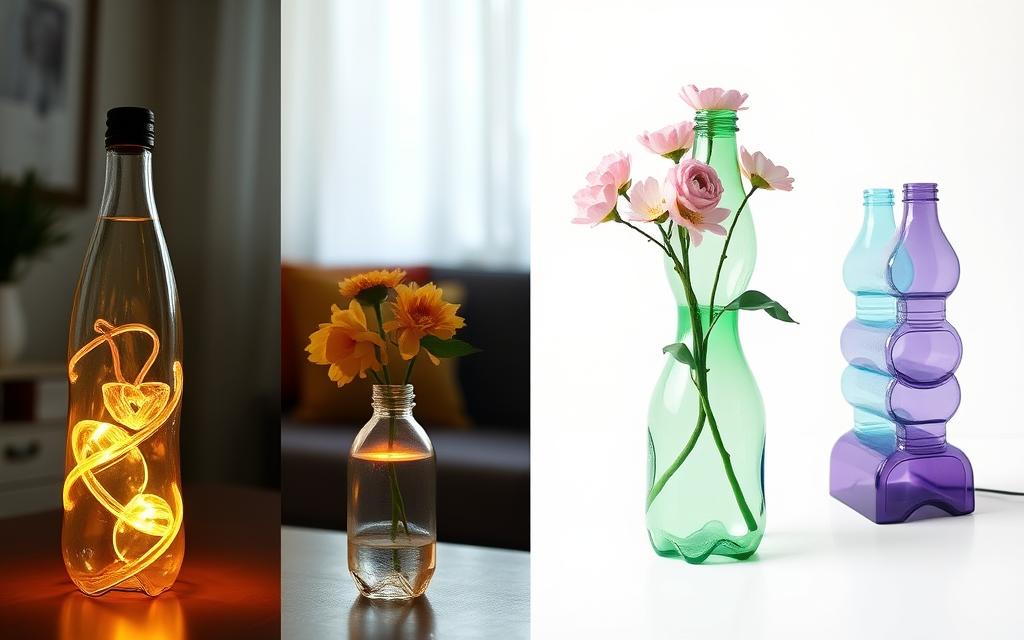
Vertical Gardens
Vertical gardens are a creative way to bring greenery into small spaces. Using stacked plastic bottles, you can create a self-sustaining irrigation system. This method is perfect for urban areas where space is limited. It also promotes healthier plant growth by improving air circulation.
Community projects often use this technique to beautify neighborhoods. Schools and local groups can collaborate to build green walls, fostering teamwork and environmental awareness. For more inspiration, check out this guide on reusing materials.
Water Filters
Emergency water filters can be made using layered filtration media. Sand, charcoal, and gravel are placed inside a plastic bottle to purify water. This simple yet effective method is ideal for outdoor adventures or disaster preparedness.
Technical specifications ensure the filter’s efficacy. Proper layering and maintenance are key to achieving clean, safe water. This innovative solution demonstrates how everyday items can address critical needs.
Plastic Bottle Chandeliers
Transform plastic bottlesinto stunning chandeliers. LED lighting integration and structural framing create a unique, eco-friendly design. These pieces are perfect for adding a touch of creativity to any space.
Electrical safety measures are essential when working with lighting projects. Proper insulation and secure mounting ensure a safe and beautiful installation. Public art grants often support such initiatives, encouraging community involvement and sustainability.
| Project | Key Features | Applications |
|---|---|---|
| Vertical Gardens | Stacked irrigation systems | Urban spaces, community projects |
| Water Filters | Layered filtration media | Emergency use, outdoor activities |
| Chandeliers | LED lighting integration | Home decor, public art |
“Upcycling is not just about reuse; it’s about reimagining the potential of everyday materials.”
These projects highlight the endless possibilities of reuse plastic and other materials. By embracing these ideas, we can make a positive impact on the environment while fostering creativity and innovation.
Conclusion: The Importance of Recycling Plastic Bottles
Small changes in daily habits can lead to significant environmental impacts. With over 50 million single-use items discarded daily, recycling and reuse plastic initiatives are more critical than ever. Programs like Recyclops, a B Corp-certified service, make it easier to manage waste responsibly through home pickup and community projects.
Embracing the circular economy reduces microplastic pollution and conserves resources. While municipal recycling is essential, DIY projects offer immediate, creative solutions. Always prioritize safety when repurposing materials, especially for complex crafts.
Join the movement toward sustainability by sharing ideas and participating in local initiatives. Together, we can transform everyday plastic into innovative solutions for a cleaner, greener future.
